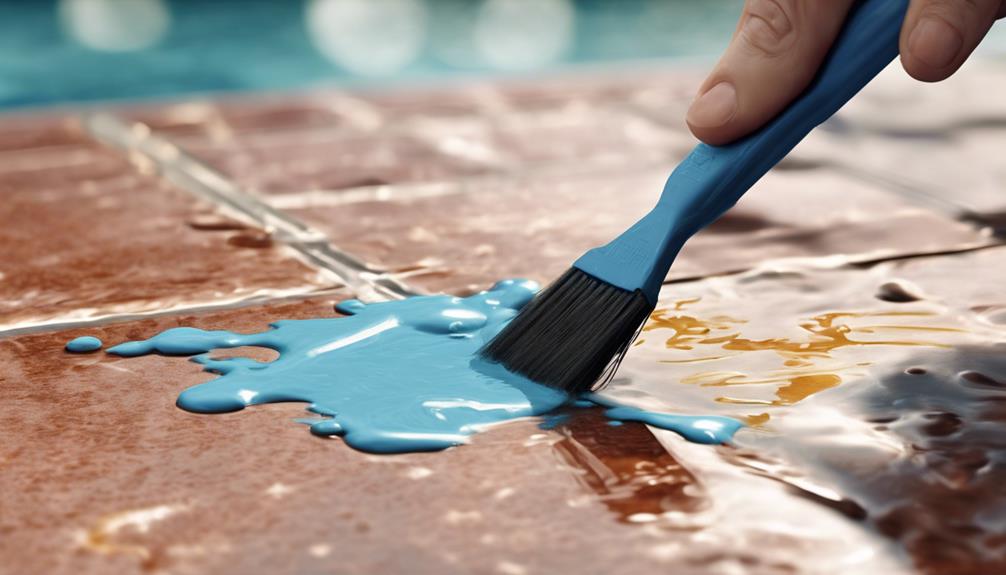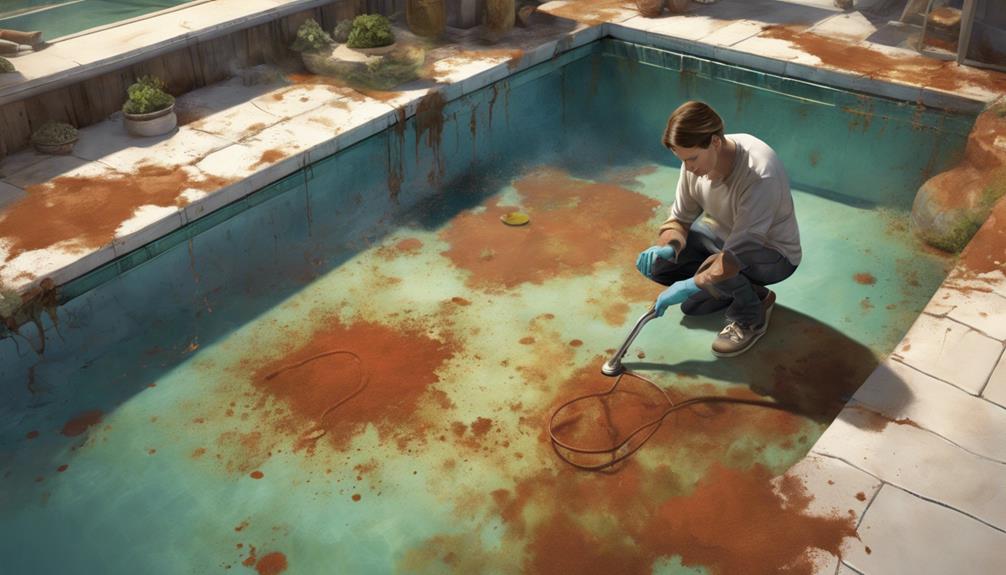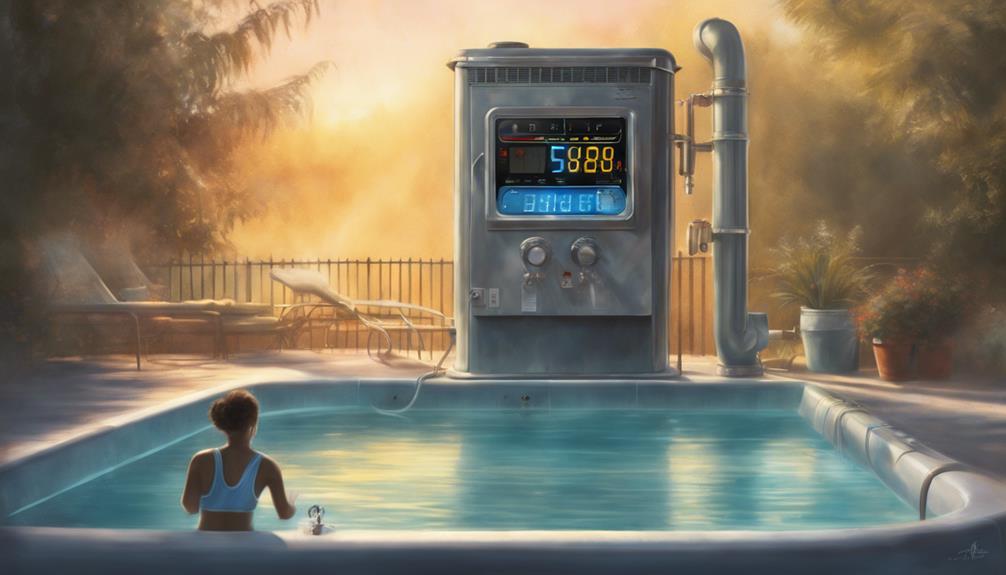Discover the key to identifying and getting rid of tough pool stains, whether they are organic or metal. Organic blemishes, which typically appear green or brown, can be treated with chlorine, while metal stains, showing dark reddish-brown colors, require ascorbic acid. Ensure your pool stays in top condition by adjusting chlorine levels, running the pump, and maintaining water balance. To address metal stains, reduce chlorine levels, add algaecide, and use Vitamin C. Keep your pool pristine and consider regular enzyme treatments to prevent blemishes in the long run. Say goodbye to pool stains and welcome a sparkling swimming pool paradise.
Key Takeaways
- Distinguish between organic (green/brown) and metal (reddish-brown) stains.
- Use granular chlorine for organic stains; ascorbic acid for metal stains.
- Shock and brush pool for organic stain removal.
- Lower chlorine, apply algaecide, and use Vitamin C for metal stains.
- Prevent future stains with enzymes, proper balance, and regular maintenance.
Identifying Types of Pool Stains
When identifying types of pool stains, it is important to differentiate between organic and metal stains based on their distinct characteristics and appearance.
Organic stains, resulting from natural elements like algae or mud, typically exhibit green or brown discoloration. On the other hand, metal stains present a darker, reddish-brown hue and are commonly caused by iron or copper deposits.
To confirm the type of stain present, simple tests can be conducted. For organic stains, adding granular chlorine and scrubbing can verify their nature if they vanish. Alternatively, for metal stains, the use of ascorbic acid or Vitamin C can slowly remove the discoloration, distinguishing them from organic stains.
Understanding the type of stain is vital for effective removal and maintenance strategies.
Removing Organic Pool Stains
To effectively address the issue of organic pool stains, it is crucial to implement a systematic removal process that targets and eliminates these stains from the pool surface.
Begin by removing leaves and debris from the pool and adjusting chlorine levels to less than 1.0 ppm. Shock the pool to eliminate bacteria and brush stains until they disappear.
Running the pool pump for a minimum of eight hours will filter out dirty water, aiding in stain removal. Additionally, maintaining proper water balance and adding commercial enzymes post-stain removal can prevent their return.
These steps, when followed meticulously, assure a clean and stain-free pool, enhancing the overall aesthetics and enjoyment of the swimming experience.
Removing Metal Pool Stains

Implementing a strategic process to eradicate metal pool stains is crucial for restoring the pool's pristine appearance and quality. When dealing with metal stains, lowering chlorine levels, using algaecide, and applying Vitamin C or ascorbic acid are key steps in the removal process. The table below outlines the steps for effectively eliminating metal pool stains:
| Step | Description |
|---|---|
| Lower Chlorine Levels | Reduce chlorine to 0 ppm before treatment. |
| Apply Algaecide | Prevent algae growth during the stain removal process. |
| Use Vitamin C or Ascorbic Acid | Apply Vitamin C directly on the stain; use ascorbic acid for larger stains. |
| Sprinkle Evenly | Guarantee an even distribution of ascorbic acid on the pool surface. |
| Circulate Water | Run the pool pump and filters for 30 minutes to circulate the treated water. |
Preventing Future Stains
For long-term maintenance of a pool's pristine condition, proactive measures can be taken to prevent the occurrence of future stains.
After removing existing stains, it is pivotal to add commercial enzymes to prevent their return. These enzymes work to lift materials from the pool bottom, ensuring a clean surface.
Additionally, maintaining proper water balance is essential in avoiding excessive staining. Regularly testing and adjusting chemical levels, as well as keeping the pool clean from debris, can contribute significantly to stain prevention.
Considering preventive measures, such as using a pool cover when not in use and scheduling routine maintenance checks, can also help in keeping your pool free from stains.
Additional Stain Removal Tips

Following the preventive measures discussed for long-term stain prevention, it is essential to be aware of additional tips for effectively removing pool stains.
When dealing with stubborn stains, consider using a stain-specific treatment product to target the type of stain present. For organic stains, a chlorine shock treatment followed by diligent brushing can help lift the stains. Metal stains may require the use of specialized stain removers like ascorbic acid or Vitamin C to break down the metal particles causing discoloration.
It is vital to follow the product instructions carefully and monitor the progress of stain removal. If stains persist, repeat the removal steps as needed. Regularly maintaining proper water balance and cleanliness in the pool can also aid in preventing future stains.
Frequently Asked Questions
How Can I Prevent Stains From Forming in My Pool?
To prevent stains in your pool, maintain proper water balance, use commercial enzymes post-removal, and consider preventive measures. Regularly monitor water quality, follow product instructions, and consult professional pool maintenance for expert support and restoration services.
Is It Safe to Swim in the Pool After Stain Removal?
After effective stain removal from the pool, it is safe to swim once water chemical levels return to normal. Regular monitoring of water quality guarantees a clean and safe swimming environment. Always prioritize maintaining proper pool balance for a pleasurable swimming experience.
Can I Use Regular Household Cleaners to Remove Pool Stains?
Regular household cleaners are not recommended for removing pool stains. Opt for pool-specific stain removers or natural remedies like ascorbic acid or Vitamin C. Using improper cleaners can damage pool surfaces and affect water chemistry. Consult a professional for safe stain removal solutions.
How Often Should I Shock My Pool to Prevent Stains?
Regularly shocking your pool is essential for preventing stains. Aim to shock your pool at least once a week, or more frequently if your pool sees heavy use or environmental exposure. Consult with a pool professional for tailored advice.
What Should I Do if the Stains Return After Removal?
In the event stains reappear post-removal, reassess water balance and filtration. Address underlying causes, such as insufficient maintenance or untreated metals. Utilize specialized treatments and seek professional guidance for long-term stain prevention and thorough pool care solutions.
What Are the Best Ways to Remove Pool Stains?
To identify pool liner stains, start by determining the type of stain and then choosing the appropriate cleaning method. Common methods include using a stain removal product, scrubbing with a brush, or treating with a chemical solution. Regular maintenance and proper water chemistry can also prevent future stains.
Is Pool Stain Removal Related to Proper Chemical Storage Safety?
Pool stain removal is directly related to proper chemical storage guidelines for safety. By storing pool chemicals properly, you can prevent leaks, spills, and accidents that could lead to staining. Following recommended storage practices can help maintain a clean and safe pool environment for everyone to enjoy.
Are Pool Stains Related to Pool Heater Operation?
Pool stains can indeed be related to pool heater operation. If your pool heater is not functioning properly, it can lead to chemical imbalances in the water, which can cause stains. By getting your pool heater regularly serviced, you can discover pool heater operation secrets that can help prevent staining.
What Are the Best Methods for Removing Pool Stains, and Can Shoreline Pools Help with This?
When dealing with pool stains, it’s crucial to consult shoreline pools repair experts for the best removal methods. Solutions like scrubbing with a pool brush, using a stain remover product, or hiring professional pool cleaners can help eliminate stubborn stains. Shoreline pools repair experts can offer tailored advice for effective stain removal.
How Can I Prevent Pool Stains While Adding a Waterfall Feature?
Prevent pool stains while adding a stunning pool waterfalls revamp by regularly cleaning and treating the water. Use stain-resistant materials for the waterfall feature and consider adding a sealer to protect the pool surface. Proper maintenance and monitoring of chemical levels can also help prevent stains and keep your pool looking beautiful.
Conclusion
To conclude, grasping the difference between organic and metal pool stains is essential for efficient removal and prevention strategies. By using specific removal techniques like granular chlorine and ascorbic acid for metal stains, and thorough brushing for organic stains, pool owners can uphold a spotless pool surface.
As per research from the National Swimming Pool Foundation, 80% of pool stains can be avoided through consistent upkeep and correct water balance, underscoring the significance of proactive stain management.










